What is SAP HANA | The Best SAP HANA Tutorial for Beginners
Are you interested in learning more about SAP HANA? Before that, a basic understanding of SAP SuccessFactors is necessary, and this blog will explain “what is SAP HANA.”
Overview of SAP HANA: What is SAP HANA?
SAP HANA was engineered to rapidly and accurately process vast amounts of data, providing instantaneous insight and action.
This in-memory computing platform can be utilized for applications such as predictive analytics, digital transformation, and real-time analytics.
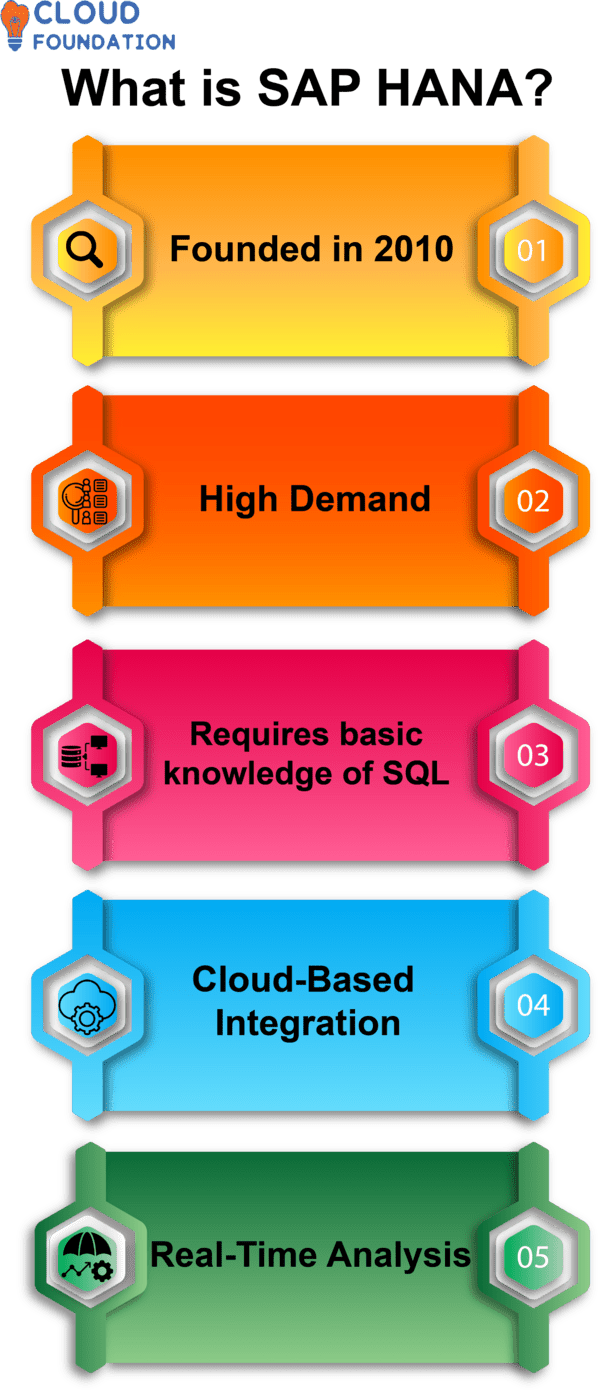
Enterprise applications such as SAP S/4HANA, SAP HANA Cloud Platform and SAP BW/4HANA utilize this data.
In-process data analysis provides organizations with timely insights and valuable data at their source.
Introduction to SAP HANA
SAP HANA is a technology and software solution that combines technology and software, enabling organizations to quickly store, process, and analyze data. It enhances corporate performance by providing real-time insights into customer behaviour, operations, and finances.
It can also be utilized for more sophisticated analytics such as machine learning, AI, and natural language processing.
It has the capacity to manage large amounts of transactional and analytical workloads simultaneously, making it ideal for real-time analytics and data-driven decision-making.
Businesses can now analyze vast amounts of data in real time and make better-informed decisions based on up-to-the minute facts.
SAP HANA features not only boasts superior speed and efficiency, but it also provides advanced analytics capabilities like predictive modelling, machine learning, and text analytics which give businesses deeper insights from their data.
It has a broad application in various sectors such as finance, healthcare, retail, manufacturing and telecommunications.
SAP HANA offers data modeling, integration, provisioning, text search, predictive analytics and geographic processing to meet all your needs. Plus, it comes with an IDE that gives programmers the toolset they need to build apps and analytics solutions quickly and easily.
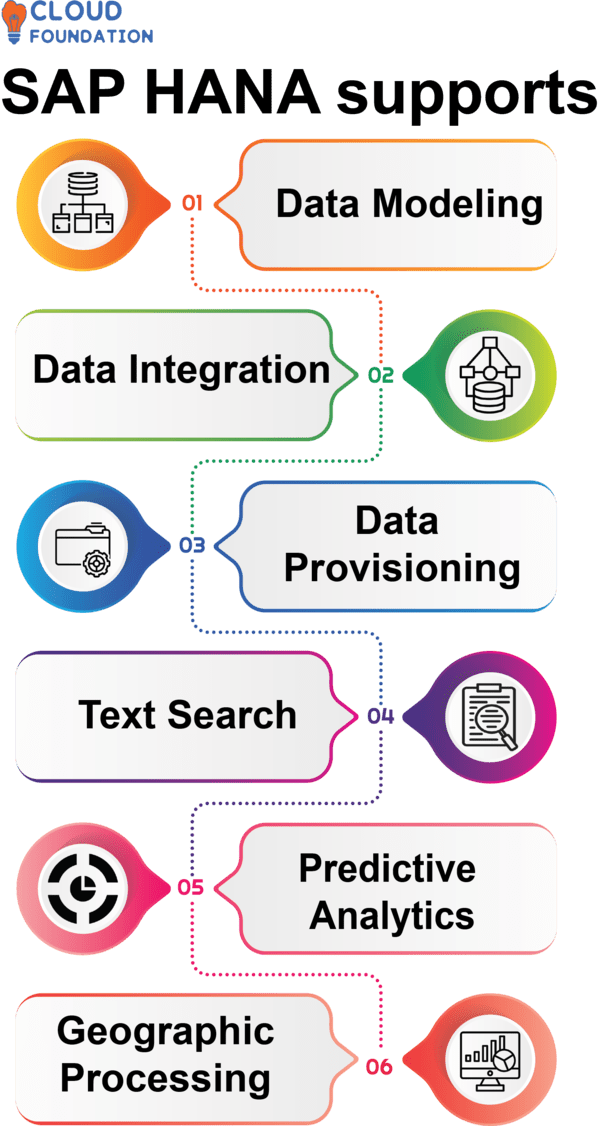
SAP HANA definition
SAP HANA is an in-memory, columnar relational database management system developed and sold by SAP SE.
It’s designed to handle large volumes of transactional and analytical data in real time, making it ideal for enterprise settings requiring rapid data processing and analysis.

Enterprises can quickly gain insights and make data-driven decisions with SAP HANA’s comprehensive analytics capabilities, such as predictive analytics, spatial data processing, and machine learning.
SAP HANA is an efficient system for processing and analyzing large data sets in real-time, giving businesses a competitive edge and unlocking new possibilities of innovation.
What does SAP HANA do and what is SAP HANA used for?
SAP HANA is an advanced system designed to facilitate real-time processing and analysis of massive enterprise data sets. Some of SAP HANA’s primary features include:
It is in-memory data storage enables fast access and processing of vast amounts of information.
SAP HANA features advanced analytics such as predictive analytics, machine learning and spatial data processing to give businesses new insights and enable informed decisions. With these features, businesses can gain new perspectives to make better decisions with confidence.
Its real-time data processing and analysis capabilities enable businesses to more quickly adjust to changing market conditions, leading to faster decisions.
It was designed from the ground up to work together and integrate with other SAP products, such as SAP ERP, Business Warehouse (BW), and CRM, providing organizations with a unified system to run all their data processing and analysis tasks.
The extensive collection of app development tools and APIs makes it effortless for enterprises to design and launch custom applications.
SAP HANA is a comprehensive data platform that gives businesses powerful tools and capabilities for real-time data processing and analysis, helping them stay ahead of competition and foster innovation.
SAP SE created this memory-resident application with columns as its focus. It can be used for real-time processing of large datasets and advanced data analysis.
SAP HANA applications typically involve:
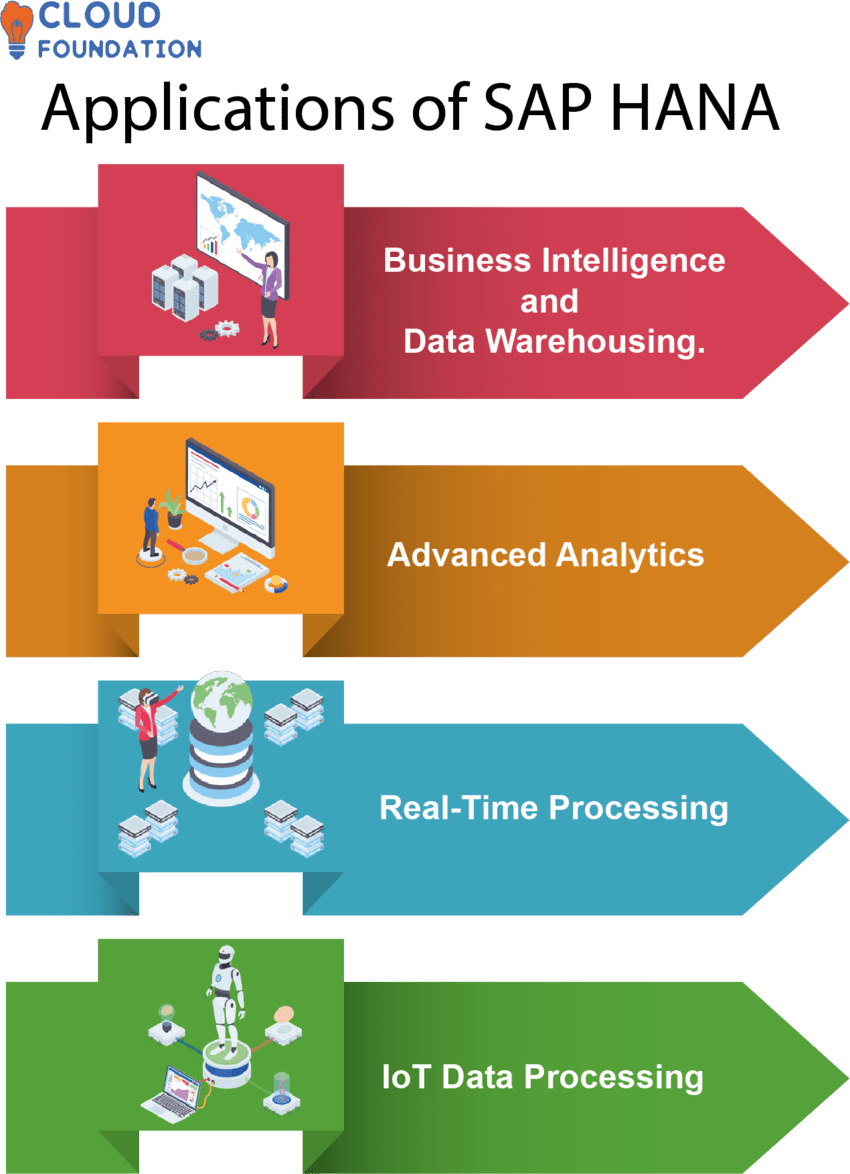
It can be utilized as a data warehouse to store and quickly analyze vast amounts of structured and unstructured information, making it ideal for business intelligence and data warehousing needs.
Predictive modeling, machine learning and text analysis are just some of the advanced analytics made possible by SAP HANA’s in-memory computing capabilities.
Online Transaction Processing (OLTP) and Enterprise Resource Planning (ERP) systems are two examples of applications that can benefit from SAP HANA’s real-time processing capabilities.
SAP HANA IoT Data Processing can process and analyze vast amounts of IoT device data in real time, giving businesses access to actionable insights.
Development of Custom Applications on SAP HANA Platform provides application developers with tools and services to design cutting-edge software that takes advantage of its in-memory computing power.
Businesses of all sizes and in a wide range of industries rely on SAP HANA to make better, faster decisions based on data.
How does SAP HANA work?
SAP HANA is an in-memory database designed for real-time analytics and real-time data processing. With its scalability and adaptability, it makes SAP HANA ideal for business analytics projects as well as real-time data processing needs.
Memory database engines save all data in RAM, making them ideal for processing and analyzing quickly.
They store information in columns rather than rows, meaning only relevant columns are loaded into memory for faster data access and analysis.
Predictive analytics, machine learning techniques, an in-memory database engine and columnar data store – these powerful tools offer complex data analysis as well as real-time insights.
This can be easily installed and managed on-premise, in the cloud, or hybrid. As your business expands, so does its need to handle massive data volumes.

SAP HANA is an innovative platform that enables enterprises to process and analyze vast amounts of data in real-time, allowing them to make informed decisions and stay ahead of their competition.
Why SAP HANA, and what are the benefits of SAP HANA?
Businesses are now able to process vast amounts of data in real-time, giving them more power for making decisions and reaching objectives.
Real-time analytics on massive volumes of information provides businesses with new insights into operations, customers, and markets.
SAP HANA’s advanced analytics help identify and fix data quality problems for a competitive edge.
SAP HANA can consolidate data from multiple sources onto one platform, offering IT landscape simplification.
SAP HANA’s superior compression algorithms deliver cost savings and increased productivity, as they enable businesses to store more data in the same amount of space.
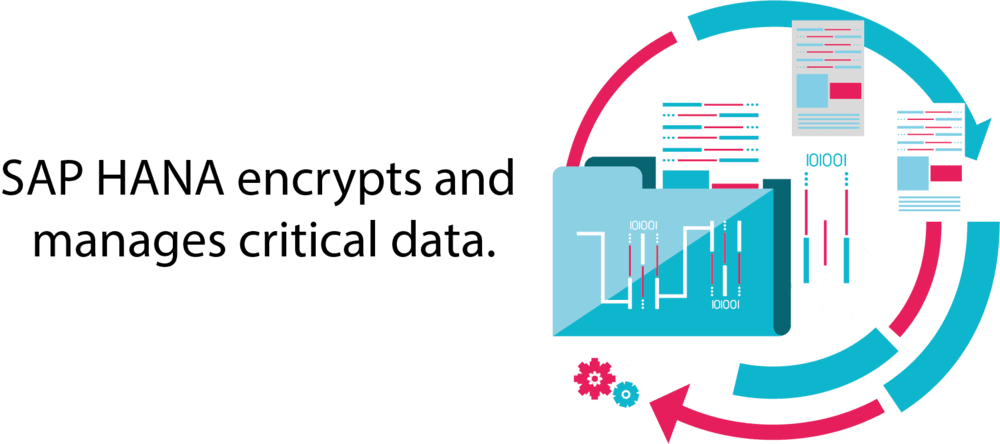
Companies may be able to reduce data analysis times, gain insight from their data, and make more informed decisions with SAP HANA’s assistance.
Advantages of SAP HANA
Increased Performance: SAP HANA utilizes in-memory computing technology, dramatically speeding up data processing. Query response times can be reduced from hours to seconds since it processes queries and transfers much more quickly than traditional disk-based systems do.
Real-Time Analytics: SAP HANA’s real-time analytics capabilities give businesses access to actionable intelligence as it happens, allowing them to make decisions with certainty and speed. This empowers businesses to take the best course of action right away.
Reduced Cost: Prices are reduced because SAP HANA allows businesses to run their databases on less expensive hardware and forgo expensive data warehouses.
Scalability: SAP HANA’s scalability means businesses can easily expand their infrastructure by adding more computers and programs as required, enabling them to adapt quickly to changing data processing demands.
Security: SAP HANA was designed with security in mind, helping prevent hackers and malicious actors from accessing sensitive information.
What is SAP HANA software and how to use SAP HANA?
SAP HANA combines an ACID-compliant database with powerful analytics and application services on a single in-memory data platform.
It is designed for the real-time processing of massive amounts of transactional and analytical data, enabling fast, precise corporate decision-making.
SAP applications, non-SAP applications, and Big Data sources are all supported for storage and analysis.
SAP HANA fundamentals provide developers with a set of tools and features to enable them to create real-time applications.
For SAP HANA beginners, it is essential to comprehend the architecture and components of SAP HANA. This encompasses its multiple layers – application, data, and database – as well as how SAP HANA connects to other enterprise systems like SAP ERP or other databases.
Furthermore, understanding how SAP HANA integrates with other enterprise databases is also crucial.
Additionally, SAP HANA can be utilized to create innovative apps that combine analytics with the integration of complex business processes to provide insight and inform better decision-making. Here are a few steps on how to get the most out of SAP HANA:
Steps on How to Utilize SAP HANA
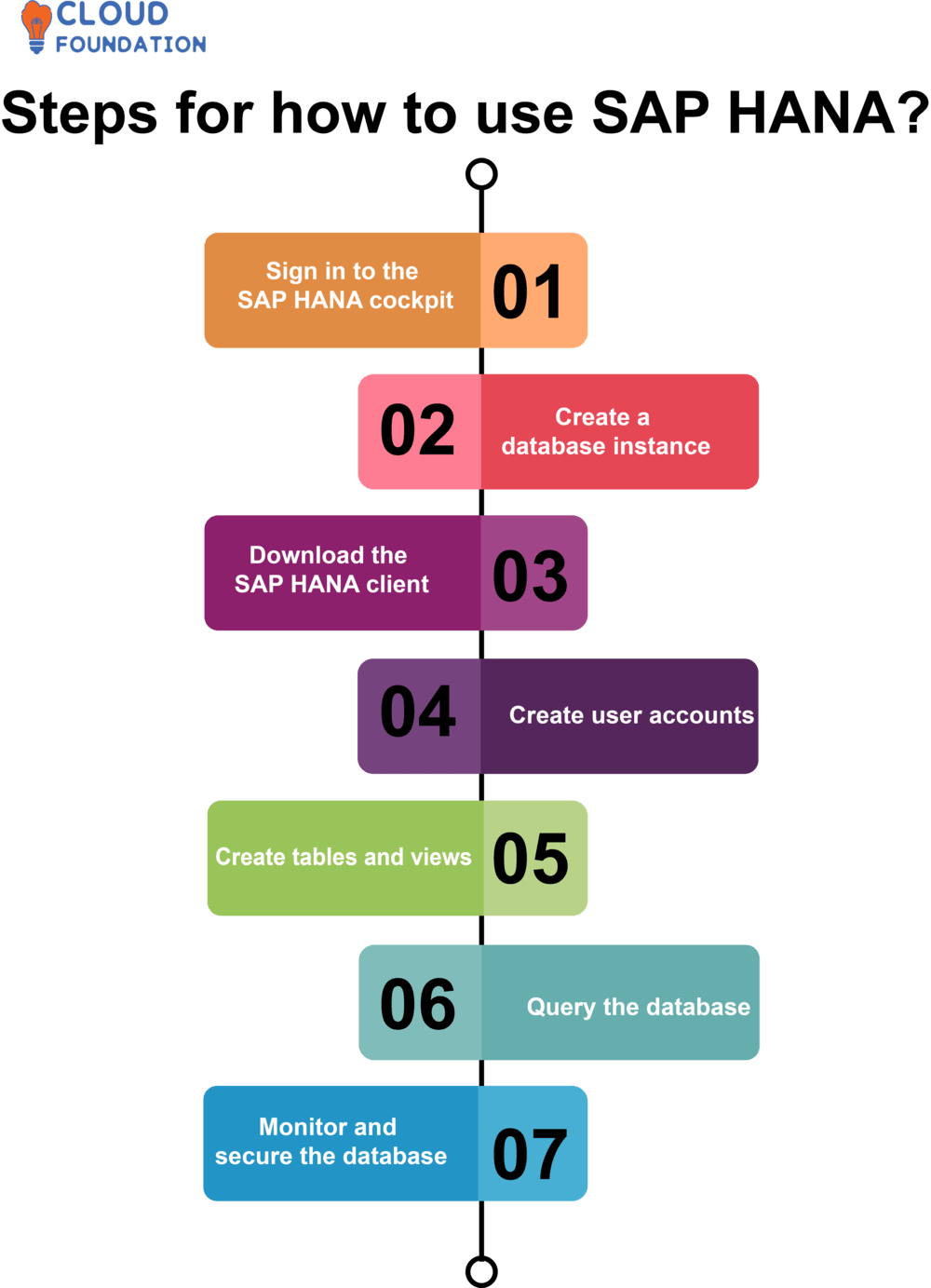
Sign in to the SAP HANA cockpit: Here, you can manage users and create databases.
Create a database instance: This database stores all your information. Multiple instances can be created if needed.
Downloading the SAP HANA client: Provides tools that make exchanging data easier between SAP HANA servers easier.
Creating user accounts: Granting restricted access to the database instance.
Construct tables and views in this instance: Inserting information here in the database instance is possible.
Query the Database: In this section, you’ll enter SQL instructions to access and modify your database.
Monitor and Secure the Database: Install any security or monitoring tools necessary for keeping your data safe and secure.
SAP S/4 HANA
SAP S/4 HANA is an enterprise application package that leverages in-memory technology to offer cutting-edge Enterprise Resource Planning (ERP) capabilities. It helps businesses streamline processes and make better decisions by offering real-time analytics, an intuitive user interface, and straightforward data models.
SAP S/4HANA’s modules address a multitude of business processes, from accounting and auditing to supply chain management and manufacturing. Furthermore, it offers solutions tailored to industries like retail, utilities, manufacturing, and service firms.
Due to its in-memory database architecture, SAP S/4HANA can process vast amounts of data almost instantly.
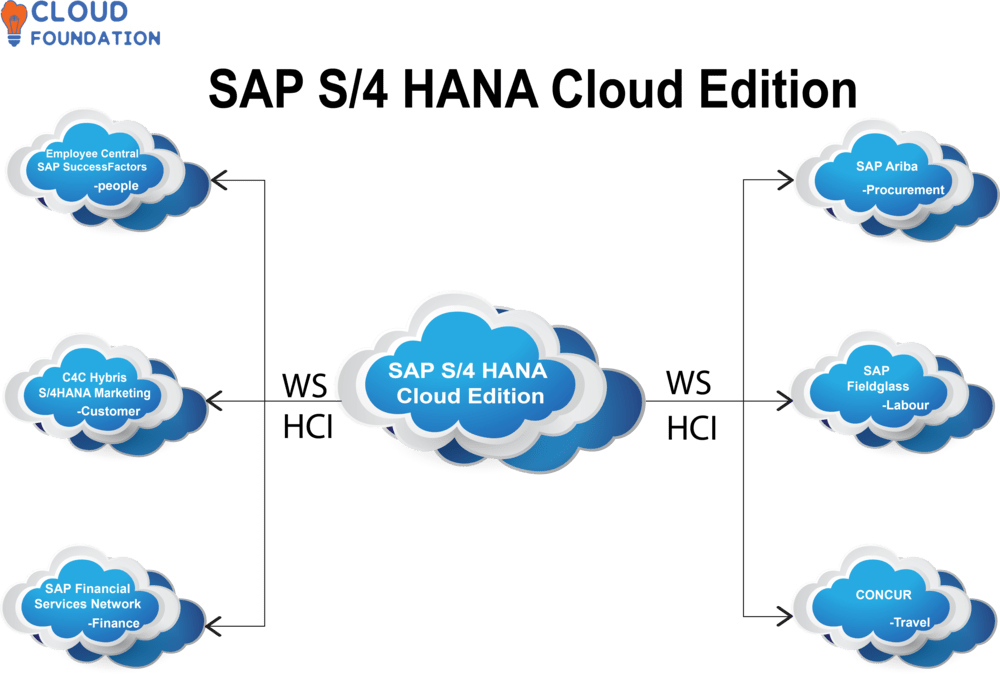
Real-time data analysis and response enable real-time pattern recognition, improved efficiency levels, and long-term strategies for the company’s flexibility; SAP S/4HANA can be deployed in the cloud, on-premises or a hybrid setup.
In addition to SAP SuccessFactors, SAP Ariba, and SAP Fieldglass, it is also compatible with other SAP systems.
SAP HANA Modules
SAP HANA is an in-memory database and application development platform designed to process large volumes of data quickly. It consists of various modules that provide functionality for various business processes.
Some key SAP HANA modules include:
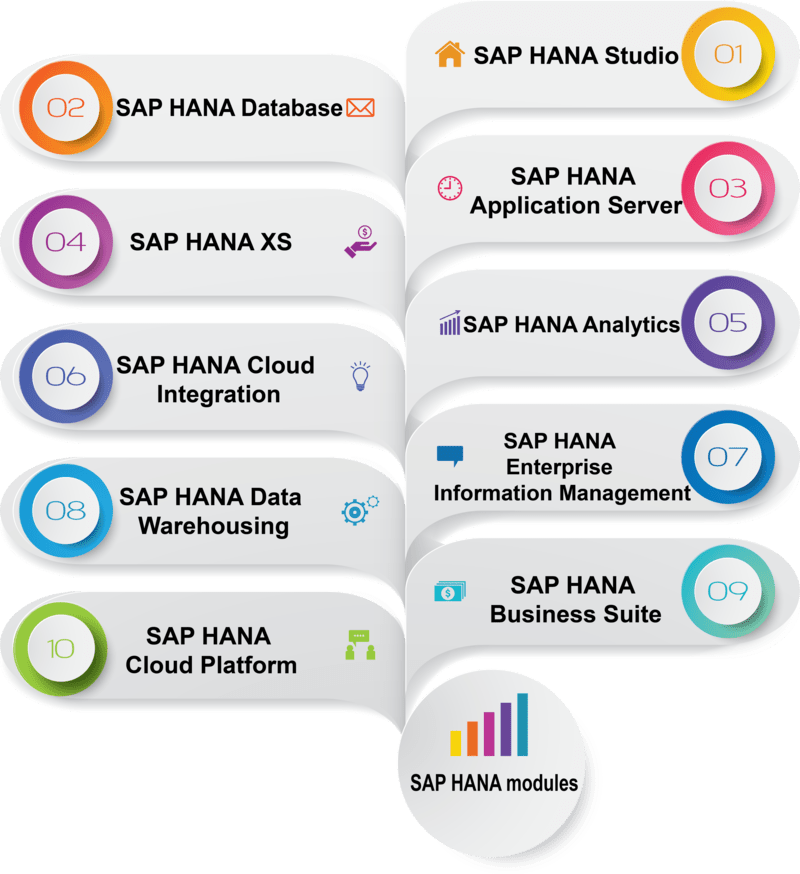
SAP HANA Studio: SAP HANA’s principal administrative and development tool. It’s a one-stop shop for creating and maintaining applications and objects for the SAP HANA database.
SAP HANA Database: This core component of SAP HANA provides in-memory database technology for real-time processing of massive data sets.
SAP HANA Application Server: This component lays the foundation for creating and deploying apps on SAP HANA. It includes software engineering, application distribution, and management resources.
SAP HANA XS: Build and run web applications natively on SAP HANA with this lightweight application server.
SAP HANA Analytics: Predictive analytics, data mining and text analytics are just a few of the advanced analytic tools explored in this subject.
SAP HANA Cloud Integration: This module allows SAP HANA to communicate with other cloud-based and on-premise programs, greatly increasing its usefulness.
SAP HANA Enterprise Information Management: This component provides resources for managing information in an organization, such as data integration, quality assurance and master data management.
SAP HANA Data Warehousing: Businesses can quickly and easily combine information from various sources into a single database for rapid analysis.
SAP HANA Business Suite: This component provides businesses with pre-made apps designed specifically for SAP HANA. It includes programs that can be utilized to manage money, purchase and sell products, and more.
SAP HANA Cloud Platform: Provides a cloud platform for developing, deploying and managing SAP HANA applications. Additionally, this package includes application integration and analytics tools.
What are the best ways to learn SAP HANA?
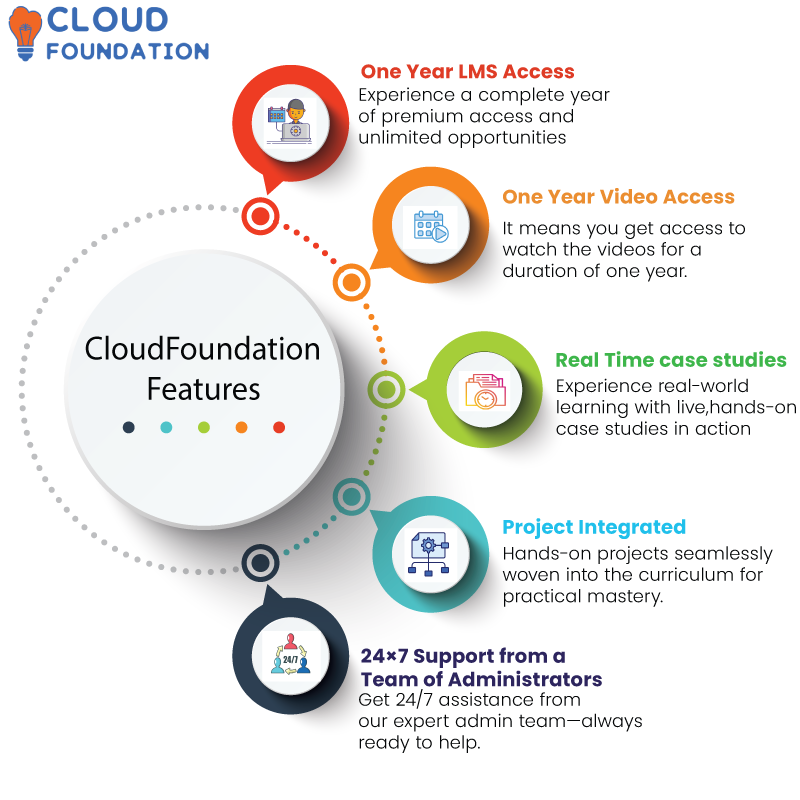
Take an online course: Numerous tutorials are available online that cover SAP HANA in-depth. From introductory levels up, these courses can offer a comprehensive look at this powerful technology.
Attend an in-person training course: CloudFoundation often provides courses teaching SAP HANA courses. Attending these events allows you to get hands-on practice with the software in a more interactive learning environment.
For deeper dives, SAP HANA blogs offer easier comprehension.
Join a certification program: SAP offers credentials for HANA specialists which can set you apart from the competition.
Read Books and Tutorials: The internet provides a wealth of resources for learning SAP HANA training videos, such as guides and tutorials.
Join an online community: This is an ideal way to get questions answered, receive advice, and stay abreast of the latest developments in this space. Additionally, be informed about certification requirements and prepare yourself to take the SAP HANA certification exam with confidence.

Saniya
Author



